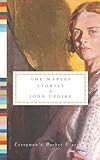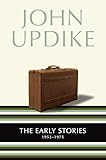 A couple of weeks ago, Harvard University’s acquired the late John Updike‘s papers, which will take up something like 380 shelf-feet in Houghton Library. For context: that’s the length of a football field, endzones included, plus enough parking lot to tailgate in.
A couple of weeks ago, Harvard University’s acquired the late John Updike‘s papers, which will take up something like 380 shelf-feet in Houghton Library. For context: that’s the length of a football field, endzones included, plus enough parking lot to tailgate in.
Now the sorting of the Updike archives begins. Where to start? What to read? My own first forays into Updike’s back pages earlier this year revealed a different writer than the one I thought I remembered… one more to my liking, if less sure of himself. Then, a few months later, I picked up The Maples Stories – a series published from the late ’50s to the late ’70s (with a ’90s coda), covering the contemporaneous unraveling of a suburban family. The jacket copy made the stories sound classically, even off-puttingly, Updikean. Perhaps still clinging to the ragged edges of Rabbit Redux, I decided to extend to The Maples a formal adventurousness Updike only occasionally indulged in his short fiction: I would read the stories backward.
The effect was strangely thrilling, like watching a time-lapse photograph in reverse, the oak tree imploding into the seed. The slight, sketched quality of the early “Snowing in Greenwich Village” and the lyrical carnality (bordering on self-parody) of “Wife-Wooing,” gained weight from the more mature pain of later stories like “Gesturing.” And the relative callowness of young Richard Maple – not initially one of Updike’s richest characters – acquired a tragic dimension from foreknowledge of where this callowness would lead him. In short, The Maples Stories, read backward, seemed too me to draw on the best of both Updikes: the younger writer’s curiosity, anxiety, and social preoccupations; the older’s greater security of technique and earned sense of pathos.


 These stories have appeared in several incarnations – a paperback called Too Far to Go, a television script of the same name, a retitled edition called Your Lover Just Called, and a selection in The Early Stories: 1953 – 1975. Now Everyman’s Library has gathered them in a single, compact, novel-like, and apparently definitive hardcover. I recommend reading them in whatever order strikes your fancy.
These stories have appeared in several incarnations – a paperback called Too Far to Go, a television script of the same name, a retitled edition called Your Lover Just Called, and a selection in The Early Stories: 1953 – 1975. Now Everyman’s Library has gathered them in a single, compact, novel-like, and apparently definitive hardcover. I recommend reading them in whatever order strikes your fancy.








